Exploring Paddle Board Surfing Techniques and Tips
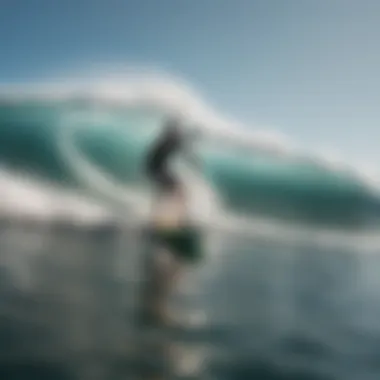
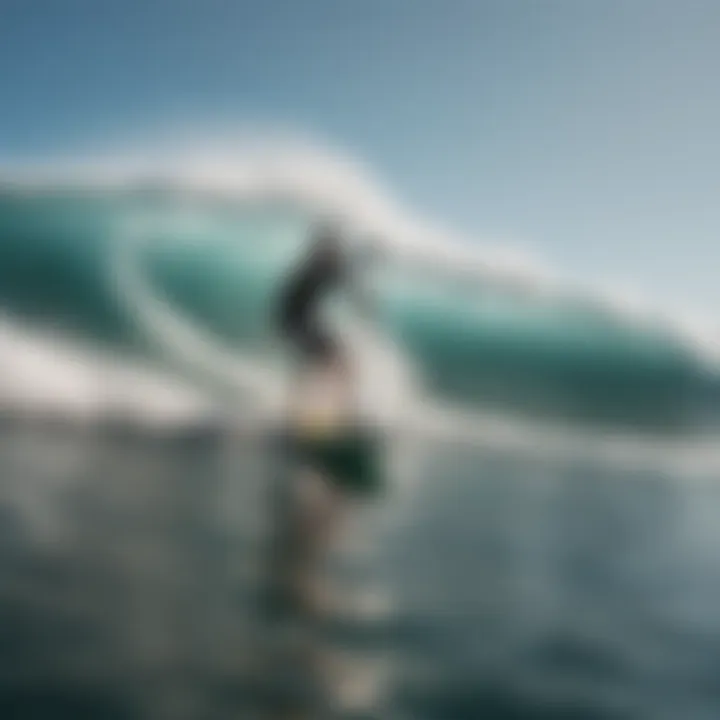
Intro
When the swell picks up and the ocean beckons, the thought of riding those waves becomes all-consuming. For those equipped with paddle boards, it raises an intriguing question: is it possible to surf on one of these expansive vessels? The answer, surprisingly to many, is a resounding yes. Paddle board surfing, or SUP surfing, has garnered attention in recent years, offering enthusiasts an alternative to conventional surfing. With their larger form factor, paddle boards possess unique qualities that can complement the surfing experience, allowing participants to paddle out and ride waves in a distinct style.
The journey to understanding paddle board surfing includes unraveling its nuances. This article delves into the practicalities, techniques, and equipment necessary for this thrilling aquatic endeavor. We aim to cover the following aspects: the difference between paddle boards and surfboards, the physical requirements of surfing while balancing on a paddle board, optimal conditions for tackling waves, safety measures that shouldn't go overlooked, and expert insights to elevate the experience.
Thus, whether you're a seasoned waterman or a curious newcomer seeking adventures in aquatic sports, this exploration will arm you with the knowledge to confidently navigate the surf on a paddle board. Ready your gear, and let’s paddle into the specifics!
Gear Recommendations
Essential Gear for Beginners
Starting any adventure in the water requires the right equipment. For newcomers to paddle board surfing, here are some fundamental items to consider:
- Stable Paddle Board: Selecting a paddle board with a wide base will enhance your stability particularly at the start. Boards like the BIC Sport SUP 10'6'' and the Isle Versa 10' are perfect for beginners.
- Adjustable Paddle: Investing in an adjustable paddle allows you to tailor the length to your specific height, enhancing your comfort while paddling.
- Personal Flotation Device (PFD): A properly fitted life jacket is crucial. Keep safety at the forefront when you’re trying something new, especially when riding waves.
- Leash: This is an essential safety item that keeps your board tethered to you, preventing it from drifting away if you happen to fall off.
Advanced Equipment for Professionals
As you gain experience on the waves and feel ready for more serious surf, consider upgrading your gear for greater performance. Here are a few advanced recommendations:
- Performance Paddle Board: For seasoned riders, a board like the Naish Nalu or the Starboard Wide Point offers enhanced maneuverability and speed. These options allow you to catch smaller or larger waves more effectively.
- Carbon or Lightweight Paddle: Upgrading to a carbon paddle minimizes fatigue during those long sessions, allowing you to glide through the water with ease.
- Impact-resistant Wetsuit: Depending on the conditions, a good wetsuit will not only keep you warm but also provide added protection. Look for options from brands like O'Neill or Rip Curl that fit well and allow flexibility.
Techniques and Tips
Skill Improvement Strategies
Once equipped with the right gear, it’s time to focus on enhancing your skills. Here are a few strategies to keep in mind:
- Practice Balance on Flat Water: Before hitting the waves, spend time practicing balance in calmer conditions. A stable stance enhances confidence.
- Know Your Paddling Technique: Effective paddling isn’t just about strength; focus on technique. Long, strong strokes on one side increase speed, while shorter strokes control your direction.
- Wave Timing: Understanding the rhythm of waves and how they break is crucial. Paddle towards the breaking wave for the best chances to catch it.
Safety Practices and Guidelines
Safety comes first in any sport, especially in water activities. To ensure a safe paddle boarding experience, follow these guidelines:
- Check Conditions Before You Go: Always assess weather conditions and tide schedules before heading out. A sudden change in tide can make waves dangerous.
- Paddle with a Buddy: There’s safety in numbers. Having a surfing partner is not only a smart practice for safety — it also provides an opportunity to learn from each other.
- Learn to Fall: It’s a natural part of learning how to surf. Understanding how to fall safely can prevent injury. Try to fall flat and away from the board, minimizing the impact.
"Paddle board surfing brings a fresh twist to catching waves, combining balance and paddling skills that challenge even the most experienced surfers."
By blending solid techniques with the right gear, novices and experts alike can experience the thrill of paddle board surfing. With determination and practice, the waves will soon become the playground you've always dreamed of.
Preamble to Paddle Board Surfing
Paddle boarding has become increasingly popular in recent years, enticing both water sports aficionados and newcomers alike. As you navigate this dynamic field, understanding paddle board surfing is paramount. It merges the graceful art of paddle boarding with the thrill of surfing, allowing individuals to experience the ocean in a unique way. This section aims to elucidate the fundamentals of paddle board surfing and highlight both its benefits and important considerations.
Definition and Popularity
At its core, paddle board surfing involves riding waves while standing on a paddle board, utilizing a paddle for navigation. This hybrid sport has gained traction due to its accessible nature; it caters not only to seasoned surfers but also to those who may be intimidated by traditional surfing.
What sets paddle board surfing apart is how it encourages participants to engage with their environment. You can often spot locals catching waves off beautiful coastlines or engaging in spirited competitions. The thrill of balancing on the board, paired with the challenge of catching the perfect wave, has drawn enthusiasts from diverse backgrounds. Just like the rise of kombucha tea, paddle board surfing has carved out its niche in the aquatic sports market.
"This hybrid sport combines the finesse of paddle boarding with the adrenaline of surfing, making it an attractive option for a wide spectrum of water lovers."
This surge in popularity can also be traced back to the growth in fitness trends. Many people appreciate paddle boarding as a full-body workout, making it appealing even to those who may have never set foot on a surfboard. Furthermore, community events and local meet-ups add a social catalyst to the mix, fostering camaraderie among participants.
Comparison with Traditional Surfing
When it comes to comparing paddle board surfing with traditional surfing, several key differences emerge. Traditional surfing typically relies solely on the surfboard. In contrast, paddle boards offer increased stability and surface area, which can be particularly advantageous for beginners. The broader design can make it easier to catch smaller waves, while stability allows for better balance, reducing the risk of falls.
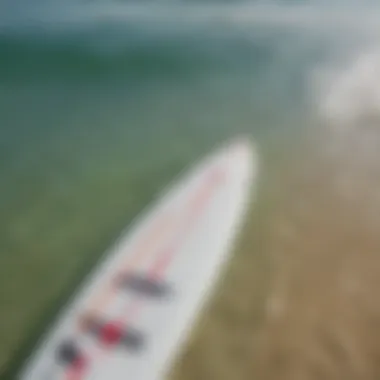
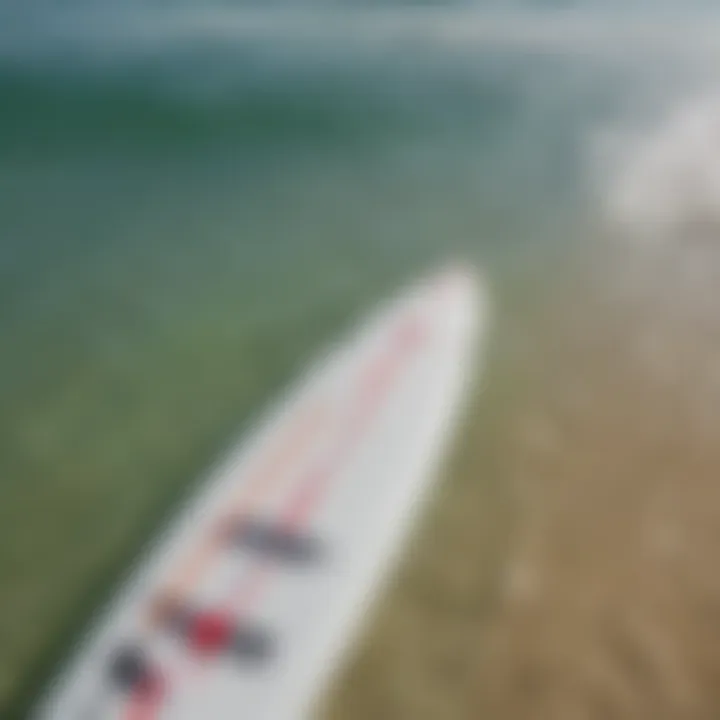
Several surfers argue that paddle boards can reshape the way one experiences the ocean. Some find they enjoy paddle boarding in spots that may be too crowded for conventional surfboards. This flexibility allows individuals to explore different water conditions and formations. Moreover, those using paddle boards can navigate shallow waters where traditional surfboards simply can't go. Their buoyancy often allows for a more relaxed experience, enabling surfers to enjoy a different style of connection with the waves.
On the flip side, experienced traditional surfers may dismiss paddle boards as less challenging or thrilling. They argue that standing up and paddling might take the edge off the pure adrenaline associated with traditional wave riding. However, the benefits extend beyond mere thrills as paddle board surfing promotes more mindful interactions with the ocean and one’s surroundings.
In summary, paddle board surfing stands as an effective platform for those dipping their toes into the world of surfing. Its adaptability and accessibility makes it a prime choice for aspiring water enthusiasts, distinguishing itself while coexisting within the broader surfing culture. Understanding these distinctions can help adventurers make informed choices about which style of wave riding suits them personally.
Understanding Paddle Boards
Paddle boards serve as the vessel for those who wish to navigate both still waters and rolling waves, making the understanding of them crucial. To master paddle board surfing, one must be aware of the various types of boards available, as well as the design elements that affect performance in the surf. Each category of paddle board offers unique advantages or setbacks ential to the activity, influencing both the fun factor and safety.
Types of Paddle Boards
All-Around Paddle Boards
All-Around Paddle Boards are designed for versatility. They’re a jack-of-all-trades, suitable for flat water, small waves, and even exploring coastal areas. The key characteristic of these boards is their wide and stable build, providing a solid platform for beginners and experienced riders alike. This stability makes them a popular choice for those dipping their toes into paddle board surfing.
What sets these boards apart are their user-friendly features: they typically come in lengths ranging from 10 to 12 feet, which enhances their stability without sacrificing maneuverability. Great for leisurely paddling, you can also ride some small waves without much fuss.
However, these all-in-one boards can fall short in performance when the waves get serious. In robust surf conditions, they may lack the agility and speed of a specialized surf board, leaving some riders wishing for more bite.
Surf-Specific Paddle Boards
For those looking to truly ride the waves, Surf-Specific Paddle Boards are the way to go. Constructed with narrower shapes and often shorter lengths, these boards excel at turning and rapid responses to wave breaks. The standout feature here is their pointed nose, which minimizes drag in rugged surf, allowing for swift paddling and smooth rides.
This design makes them beneficial for genuine surf conditions. When you find yourself facing larger waves, a surf-specific board can mean the difference between a thrilling ride or swimming with the fishes. However, with less stability than an all-around board, they might not be the best fit for anyone still trying to master their balance.
Race Paddle Boards
Race Paddle Boards lean toward the competitive side of the spectrum, crafted primarily for speed and distance. These boards have sleek shapes and are typically longer than others, stretching up to 14 feet or more. The main feature here is their streamlined design, allowing paddlers to glide with minimal resistance.
Their appeal surrounds performance in race scenarios or long-distance paddling. For thrill-seekers and competitive athletes, these boards can vastly improve paddling speed. However, they demand a higher level of skill. Smaller paddle areas and potential instability can deter beginners, leading to unwanted wipeouts.
Design Features Impacting Performance
Board Shape
The shape of a paddle board has a profound effect on its surfing capabilities. Rounded boards often deliver better stability on calm waters, while tapered edges facilitate sharper turns in the surf. This characteristic becomes crucial when navigating the drop of a wave; a flatter board shape is kinder to beginners but may lack performance at higher speeds.
For surf enthusiasts, a pointy nose reduces drag, allowing the board to pierce through the waves. It's like comparing the difference between cruising down the highway in a sedan versus racing in a sports car. While the sedan is comfy, the sports car gets you where you want fast—but at a cost.
Length and Width
Length and width play pivotal roles in how a paddle board behaves on water. Longer boards generally provide more speed and tracking, but a wider board enhances stability. This gives paddlers room to breathe, especially when standing in turbulent waters.
Consider the balance here: a longer board may glide smoothly but can feel heavier. Shorter, wider boards, on the other hand, might give riders confidence but lose speed, particularly on choppy waters.
Fin Configuration
Fins are the unsung heroes of paddle board design. They contribute significantly to maneuverability and tracking. A single fin setup provides stability and speed, which is top-notch for an even glide. In contrast, multiple fins can enhance control, especially in turns, like having your own personal navigation system.
Yet, more fins may complicate things for a beginner, as they can alter the board's responsiveness in unpredictable ways. Riders must find the right configuration that aligns with their comfort and the conditions they plan on tackling.
Each choice in paddle board design impacts the surfing experience, especially for those seeking specific performance outcomes.
Overall, understanding paddle boards and their design features arms enthusiasts with the knowledge needed to make informed choices that can transform the aquatic experience, making it not just enjoyable but also safe and effective. This lays the groundwork for successfully transitioning to paddle board surfing.
Technical Aspects of Surfing on a Paddle Board
When it comes to paddle board surfing, there are numerous technical elements that can dictate the entire experience. Understanding these nuances is essential for maximizing enjoyment and performance. Effectively selecting waves, mastering paddling techniques, and recognizing the suitable conditions for each scenario can elevate your time on the water significantly. Let's discuss these elements in detail, starting with wave selection.


Wave Selection and Conditions
Understanding Wave Types
Understanding the different types of waves is crucial for any paddle board surfer. Waves generally fall into a few categories: beach breaks, reef breaks, and point breaks. Beach breaks are often characterized by their unpredictability, while reef breaks deliver powerful and cleaner waves, making them a good choice for those with some experience. Point breaks, on the other hand, create longer, more consistent rides due to the way the waves peel along the shore.
Each type has its unique attributes. For paddle board surfers, choosing waves that provide enough push and are not overly challenging can enhance the overall experience. The distinct curvature and shape of various waves greatly influences your ability to catch and ride them effectively, impacting your performance dramatically.
Optimal Conditions for Paddle Boarding
Finding optimal conditions for paddle boarding is another significant aspect. These conditions include factors like tide, wind, and swell size. For instance, a gentle onshore wind can produce ideal waves, while strong offshore winds might flatten them out. Furthermore, specific tide patterns can either expose or hide surf spots, affecting how well you can take off.
Typically, waist-high to shoulder-high waves provide a good balance for both beginners and more advanced surfers. They allow for improvement in technique without overwhelming the paddler, making it a popular choice. Knowing when to hit the water based on weather patterns and tidal changes is a skill every paddle board surfer should develop.
Identifying Surf Breaks
Knowing how to identify the best surf breaks enhances your paddle surfing journey. A good break will usually have consistent waves and a safe entry and exit point. Look for established surf spots that seasoned surfers recommend, but don’t shy away from scouting areas for yourself. Observing how the waves break and speaking to local surfers can lead to discovering hidden gems.
The unique feature about locating surf breaks is that conditions can change hourly, sometimes even minute by minute. Therefore, being adaptable and aware of your surroundings can lead to a rewarding experience on the water. This skill improves with practice and pays off with every successful ride you get.
Paddling Techniques for Surfing
Taking Off
The act of taking off on a paddle board involves unique timing and body positioning. As you enter the wave, you need to prop yourself up, balancing well as you transition from paddling to riding. The key here is to remain low and centered when the wave approaches, using your paddle for stability. Successful take-offs can lead to smoother rides and boosts confidence for tackling tougher waves in future sessions.
Practically speaking, this technique has the potential to either make or break your session. A clean take-off can mean the difference between riding a wave successfully or nosediving into the face of it, which is never a pleasant outcome.
Bracing for Waves
Bracing for waves is about preparing your body for the challenges that come when riding. Whether it’s a small chop or a big surf, having the right posture can mitigate falls. The key feature for this technique revolves around being dynamic—shift your weight fluidly as the ocean changes its energy.
Learning how to brace might feel intuitively easy, but it's something that requires practice. Implementing this technique can lead to a more enjoyable and controlled surfing experience.
Turning and Maneuvering
Turning and maneuvering on a paddle board shapes your ability to navigate the surf effectively. This skill not only involves turning the board in response to wave conditions but also managing your balance as you shift directions. Engaging your core and using your paddle for strokes is essential. Strong paddling strokes can help you make sharp turns that keep you in your desired position during a ride.
The significant aspect of mastering this technique is maintaining speed while doing so. A well-executed maneuver can allow you to remain in the wave longer and link up with other waves, enhancing your overall session.
Mastering these technical aspects of paddle board surfing can truly enrich the aquatic experience, turning what could be merely splashing in the waves into a sport of skill and finesse.
Physical Demands of Paddle Board Surfing
Paddle board surfing is more than just a leisurely float on the water; it's a physical workout demanding both endurance and strength. As one navigates the waves, they engage various muscle groups while honing balance and coordination. Understanding these physical demands is key for anyone looking to take the plunge into this exciting sport. The unique combination of paddling, riding the waves, and maintaining stability makes paddleboard surfing a full-body workout that can offer significant health benefits.
A solid grasp of what is required physically helps surfers tailor their training programs. By doing so, they can boost performance while minimizing risks of injury. It’s crucial to consider these aspects before hitting the waves, especially for beginners.
Endurance and Strength Requirements
Engaging in paddle board surfing necessitates a blend of endurance and strength. This combo is vital for paddling against currents or catching a wave. Paddling can be a taxing activity, so developing cardiovascular endurance is essential. Relying on upper body strength also plays a major role since a good portion of the action focuses on the arms and shoulders. Lay off the easy stuff; pushing your limits can yield greater rewards.
Regular training can help improve coordination and overall strength. Here are some specific exercises that can enhance performance:
- Push-Ups: Great for building upper body strength.
- Plank Variations: They develop core stability, which is crucial.
- Interval Running: Increases cardiovascular endurance.
Different types of waves can also affect the physical demands of the sport. Riding larger waves calls for explosive strength and endurance, while smaller waves might focus more on technique and balance. Thus, a warm-up before hitting the water can’t be emphasized enough!
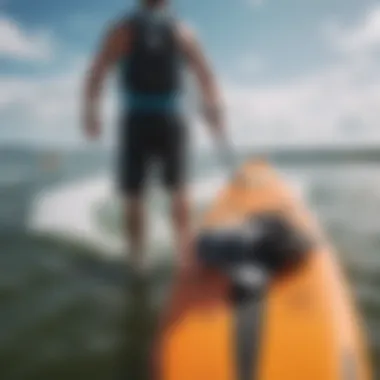
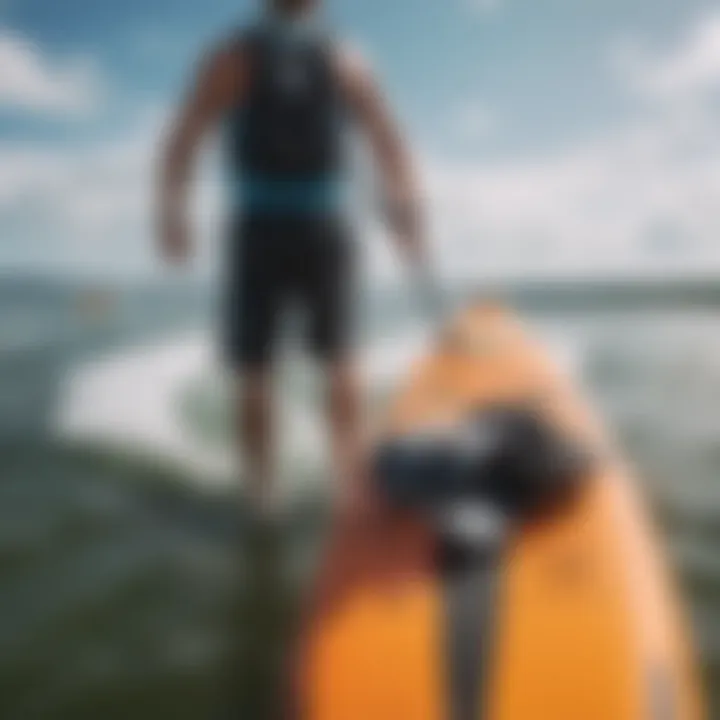
Balance and Core Stability
When it comes to paddle board surfing, balance holds the reins. It’s the foundation that keeps surfers upright amid the unpredictability of the waves. A strong core not only helps maintain an upright position but also facilitates smoother paddling and turning motions. If the core is weak, a surfer may find themself splashed in no time!
Balancing on a paddleboard can demand a fine-tuned sense of stability. It’s not just about standing still; it’s about being in tune with the ever-changing conditions around. Here are some ways to improve balance:
- Yoga: Various poses can enhance balance and flexibility.
- Stability Ball Exercises: They are excellent for core conditioning.
- Single-Leg Stand: Incorporate this into your routine for better stability.
In summary, paddle board surfing is a fantastic way to boost fitness while enjoying the great outdoors. Improving endurance, strength, balance, and core stability will pave the way for not only a more enjoyable experience but also a safer one. For those eager to step out into the waves, preparing adequately is the key to unlocking the full potential of this rewarding activity.
"Preparation is the key to success."
The blend of these physical demands can ultimately define the experience on the water, and understanding them prepares you for a thrilling adventure ahead.
Safety Considerations
Paddle board surfing can offer a thrilling experience, yet it also demands a heightened awareness of safety protocols. Prioritizing safety is crucial to ensure an enjoyable adventure without unnecessary risks. The open water presents various challenges, and understanding the intricacies of ocean safety can empower paddlers to navigate effectively, enhancing both skills and enjoyment.
Understanding Ocean Safety
Recognizing Currents
Being able to read and appreciate currents is key. Recognizing currents is a fundamental skill for anyone venturing into surf areas. Currents can range from benign sways to powerful rip tides that can pull even expert surfers away from safety. Understanding how currents interact with wave formation can significantly affect one's surfing experience.
The primary benefit of mastering currents is that it directly contributes to a safer experience. For instance, if you can identify a rip current, you can swim parallel to the shore to escape its grip instead of exhausting yourself against it. While challenging to detect sometimes, the unique feature of local currents is often tied to the geography of the coastline and underwater topography. A disadvantage, however, is that they might vary from day to day. So, fresh observations and understanding are vital.
Wear Proper Gear
The right gear can make a world of difference in safety while paddle boarding. Proper equipment—such as life jackets, leashes, and wetsuits—ensures you're prepared for unexpected situations. Life jackets are not just legal requirements in many locations; they can be lifesavers. Similarly, leashes guarantee that even if you fall off your board, you won't lose it to the waves, making retrieval easier. A significant feature of wearing suitable gear is that it allows for comfort, boosting your confidence. For example, wearing a wetsuit can insulate you against cold water, making longer sessions possible. However, one might argue about the drawbacks of carrying extra weight, especially in warmer waters. It's a balancing act where comfort and safety must work hand in hand.
Common Risks Associated with Surfing on Paddle Boards
Collisions
Collisions with other surfers or obstacles present tangible risks. In crowded surf spots, the risk of a collision escalates, particularly when varying skill levels mingle. Early awareness and understanding of your surrounding can mitigate risks. For instance, maintaining a safe distance from others can go a long way in preventing accidents. The unique element of smooth communication between surfers can enhance everyone's experience. Recognizing signals and maintaining a safe distance becomes essential when there are many people in the water. On the downside, collisions can cause injuries, especially if one doesn't anticipate the trajectory of a wave or another board.
Equipment Failure
Mechanical or structural failure of your equipment can lead to serious problems. For paddle boarders, this often relates to deflation or damage to the board. Regular maintenance is vital in preventing sudden mishaps. Knowing how to check your board for leaks or weak spots, however, adds another layer of required vigilance. It’s a beneficial aspect to ensure your gear is inspected regularly, potentially safeguarding you from uncomfortable scenarios. A unique aspect of equipment failure is that it can happen without warning, catching even experienced paddlers off guard. Keeping an eye on your equipment quality can avoid problems down the line.
Environmental Hazards
The natural environment presents its risks, ranging from sudden weather changes to unexpected wildlife encounters. Understanding conditions like tide shifts and potential storms can support a safer experience. A key characteristic of environmental hazards is their unpredictability—changes in weather can occur quickly, leaving little time for preparation.
Awareness of your surroundings allows you to recognize potential threats, such as large waves or even dangerous marine life. While the excitement of nature is engaging, it also requires respect and caution. Notably, the unique feature of environmental hazards is their inherent variability, meaning today’s perfect conditions might not be the same tomorrow. This variance pushes surfers to maintain a flexible mindset and to stay informed.
Always prioritize safety—your joy on the water hinges on how well you understand the environment and recognize potential risks.
In summary, understanding the safety considerations while paddle boarding empowers surfers to enjoy the thrill while mitigating risks associated with this water sport.
The Ends and Recommendations
This section draws to a close an insightful discussion about the art and practicality of surfing on a paddle board. The intersection of paddle boarding and surfing is a treasure trove of potential opportunities, offering both challenges and rewards. The recommendations here are designed not only to guide enthusiastic newcomers but also to remind seasoned paddle surfers of crucial considerations that can elevate their experience.
Is Paddle Board Surfing Right for You?
Determining if paddle board surfing aligns with your interests and abilities is a pivotal consideration. Here are some factors that can help you figure it out:
- Personal Fitness Level: Paddle board surfing demands a certain level of fitness and endurance. Consider how often you engage in physical activities. Regular practice not only boosts your strength but also improves your balance, which is crucial for this sport.
- Local Conditions: Assess your local water conditions. It’s not just about whether the waves are present, but also their nature—smooth swells are far different from choppy, unpredictable waves. Make sure the environment complements your wrk in this sport.
- Goal Orientation: Are you looking for a laid-back experience or seeking the adrenaline of riding higher waves? Knowing what you seek from this form of surfing can help narrow down your commitment.
- Equipment Access: Do you have access to a suitable paddle board? Surf-specific boards cater to different needs and skills. The right board can significantly enhance your surfing performance.
Choosing to paddle board surf means making a conscious choice to blend fun with focus. A bit of self-reflection on these aspects will guide you to the right decision.
Resources for Further Learning
To deepen your understanding and skills in paddle board surfing, it’s essential to tap into quality resources. Here’s a list of recommendations:
- Books: Look into titles such as "The Stand Up Paddleboard Book" by Dave Kalama, which offers insights into techniques and equipment.
- Online Forums: Platforms such as reddit.com feature active discussions and advice from fellow paddle boarders.
- Videos: YouTube has countless tutorials ranging from beginner tips to advanced techniques. Watching experienced surfers can provide invaluable insights.
- Local Classes: Consider engaging with a local surf school that offers paddle board surfing lessons. In-person guidance can rapidly accelerate your learning curve.
- Community Groups: Check platforms like facebook.com for groups dedicated to paddle board surfing. These communities are gold mines for advice and camaraderie.
In wrapping up this comprehensive dive into paddle board surfing, remember it’s all about enjoying the ride—both on the waves and in your learning journey. Embrace the adventure, stay safely within your limits, and, most importantly, have fun!















